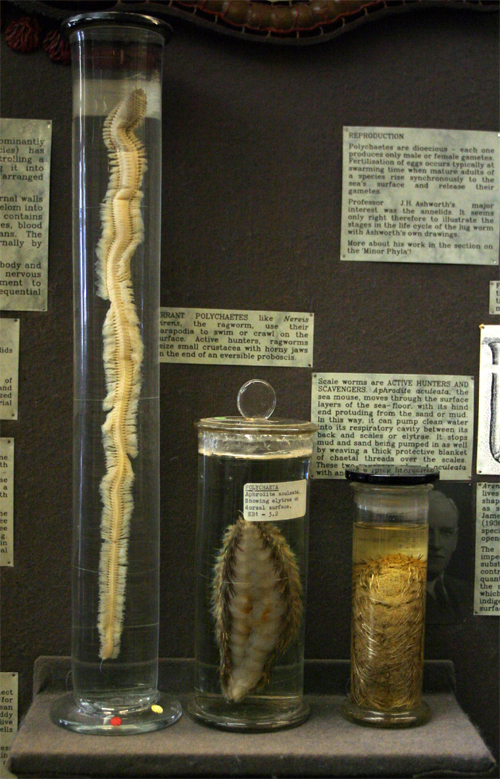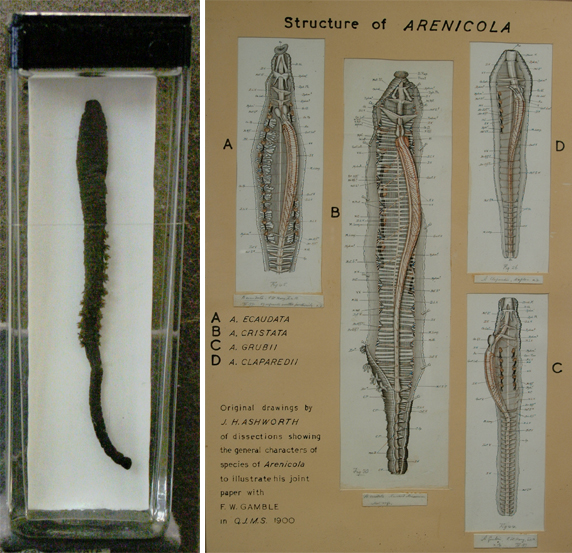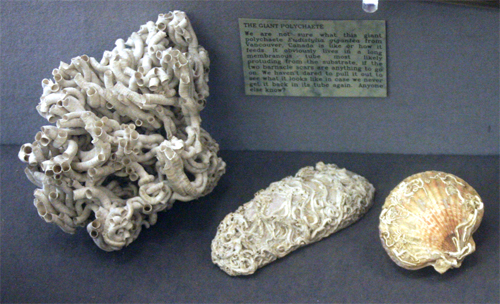
CLASS POLYCHAETA | |
Polychaetes are common marine annelids (5300 species) with paddle-like appendages or parapodia bearing numerous bristles or chaetae and often gills. They have a distinct head region, often with sensory tentacles and simple eyes. Polychaetes are dioecious – each one produces only male or female gametes. Fertilisation of eggs occurs typically at swarming time when mature adults of a species arise synchronously to the sea’s surface and release their gametes. Fertilised eggs develop into trochophore larvae, which spend some time swimming in the plankton before maturing into bottom living adults. Polychaetes have adapted to a wide range of marine habitats and in so doing have evolved three main types of life style: errant or free living, burrowing, tube dwelling. A few bore their way into hard substrates like corals and shells. Their secretive habits usually result in their being overlooked by casual observers. Errant polychaetesNereis virens, the ragworm uses its parapodia to swim or to crawl on surfaces. Active hunters, ragworms seize small crustacea with horny jaws on the end of an eversible proboscis.Scale worms are active hunters and scavengers. Aphrodite aculeata, the sea mouse, moves through the surface layers of the seafloor with its hind end protruding from the sand or mud. In this way, it can pump clean water into its respiratory cavity between its back and its scales or elytrae. It stops mud and sand being pumped in as well by weaving a thick protective blanket of chaetal threads over the scales. These two specimens show A. aculeata with and without its blanket. |
 |
BurrowersArenicola lumbricoides, the lugworm lives as a sedentary burrower in U-shaped mucus-lined tubes in the sand. The lugworm has no parapodia to impede its burrowing through the substrate with peristaltic muscular contractions. To feed, it swallows great quantities of the substrate and digests the small amount of organic debris that is edible. Its tube is formed s indigestible remains are voided on the surface as conspicuous worm casts. Professor J.H. Ashworth’s major interest was the annelids. His drawings illustrate the internal structure of the lug worm. 
|
 |
Tube-dwelling polychaetesSome polychaetes make tubes to protect their soft bodies, to serve as lairs for catching passing prey, to provide clean oxygenated water in sandy or muddy substrates, or to allow worms to live attached to rocks, shells and sea-weed. Tube dwellers typically possess special anterior structures for feeding as well as anterior gills but have no parapodia. Some tubes are made from membranous secretions or calcareous materials; others are made by cementing sand-grains together. |
 |
Below: Eudistylia gigantea, a giant tube-dwelling polychaete. This specimen in its membranous tube came from Vancouver, Canada. 
|
|






